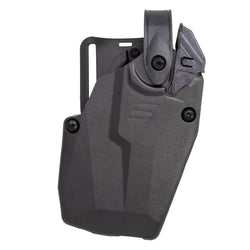When it comes to personal protection, we often think more about the gun, with defensive ammunition taking a bit of a backseat. I can’t even count the number of times I’ve been asked what my choice carry or home defense weapon is. But ammo preferences? Shoot. It’s maybe come up just a handful of times.
It’s always about the gun… which I honestly think is the wrong way of looking at it.
Sure, that sexy new striker-fired 9mm might look like you mean business and feel great in the hand. But have you ever stopped to think about what’s really doing the heavy lifting of actually stopping a threat in a self-defense situation?
And because not all ammunition is created equal, your choice of carry ammo is incredibly important in personal defense applications. Yet, it’s often overlooked.
As you walk through the ammo aisle of your local gun store or peruse the web to compare prices, you’ll find a host of options. FMJ ball ammo, soft points, hollow-points, frangible, cast lead, round nose, flat points, plated vs. jacketed options… the options are seemingly endless.
The truth is, the ammunition you choose might make the difference between effectively stopping a threat and creating a dangerous situation that could fail to effectively stop a threat or worse, due to overpenetration, unreliable feeding, or inconsistent terminal performance.
That is to say, your choice in what 9mm ammo you use for defense shouldn’t just be about stopping power. It’s a decision you need to weigh carefully, thinking about control, consistency, and overall safety and effectiveness.
So, let’s talk about what defensive ammunition actually is (and isn’t), why it matters, and why any ol’ box of 9mm ammo won’t cut it, shall we?
What is Defensive Ammunition?
Before we get too far into the weeds, let’s first establish what defensive ammunition is and what it isn’t.
In a very general sense, defensive ammunition is designed to stop a violent threat as quickly and efficiently as possible while minimizing danger to innocent bystanders.
This means creating incapacitating wounds with enough penetration to reach vital organs and internal tissue, but without overpenetrating and exiting the target. All while maintaining consistency.

So, you’re really only looking at hollow points and some soft points, as they’re typically purpose-built to provide reliable penetration and super-fast expansion, effectively “mushrooming” out to create devastating wound channels and stopping within the soft tissue of the body.
In other words, it stops the threat by eviscerating soft tissue, but drastically reduces the risk of over-penetration that could threaten the safety of innocent bystanders and loved ones.
Hollow points do this exceptionally well.
Hollow Point Ammunition
As the name implies, hollow points feature a hollowed-out cavity in the nose of the bullet. Upon impact, this cavity causes the bullet to expand rapidly, creating a larger wound channel while reducing the likelihood of over-penetration.

The advantages here are clear. First, that controlled expansion maximizes stopping power by transferring more energy to the target. In a life-or-death moment, you want a round that can reliably stop a threat as quickly as possible. Hollow points are engineered to do exactly that, as they cause massive internal wound cavities and eviscerate organs and soft tissue.
It’s both fascinating and terrifying.
Second, as the energy is transferred to the target and the projectile expands and flattens, it faces more hydraulic and tissue resistance, and it quickly loses momentum. As such, the likelihood that the round will not overpenetrate and, instead, come to a stop within the body of the threat is much higher than that of an FMJ projectile.
FMJ Ammunition
Full metal jacket (FMJ) ball ammunition and other target-geared ammo options, on the other hand, do none of those things. Well, usually.
And in the close confines of a home or a crowded parking lot, that difference could be the deciding factor between a defensive success and finding yourself on the wrong side of the legal system.
FMJ rounds typically feature a soft lead core encased in a harder copper or steel jacket. These are your bread-and-butter range rounds. Plain and simple.
They’re affordable, reliable, and great for practice. They feed smoothly in nearly any firearm and leave clean, round holes in paper targets. But that’s about where their usefulness ends.
FMJ ammo is especially dangerous in terms of overpenetration risks and ineffective stopping power. These non-defensive ammo types typically don’t mushroom, so tissue damage is fairly minimal, and they can easily pass through and exit the human body, putting innocent property and passersby at risk.
Not a good time. For anyone.
Brass vs. Steel Casings: Does It Matter?
Case material matters. That’s the short and skinny of it.
The vast majority of defensive ammunition uses brass casings, and for good reason. Brass is malleable, corrosion-resistant, and creates a reliable gas seal in the chamber when fired, ensuring consistent cycling and extraction. It’s also reloadable, which is a plus for handloaders.

Steel-cased ammo, on the other hand, is cheaper to produce but is often harder on extractors and prone to feeding issues in certain firearms. Steel doesn’t expand and seal the chamber as well as brass, which can lead to inconsistent velocities and increased fouling.
While it’s fine (in moderation) for casual range work and informal target practice, I wouldn’t advise using steel-cased ammo in a defensive scenario. And honestly, I’m not sure you’ll find any on the gun store shelves.
Brass or nickel-plated brass casings are always better. Always.
Top Self-Defense 9mm Ammo Offerings
Now that we’ve covered the basics, let’s look at a few of my current favorite options in the 9mm world. These aren’t the only good defensive loads out there. But they’re certainly some of the best that I’ve found, both in terms of terminal ballistics and overall handling and performance.
Speer Gold Dot
Speer Gold Dot is a personal favorite. It was the first defensive load I carried, and I’ve yet to experience a single malfunction or quality issue with it. It’s an absolute legend in the world of defensive ammunition, and it earned its reputation the hard way. It’s seen ample real-world service by law enforcement agencies and concealed carriers alike. And I swear by it with my Glock 17, as does my LEO wife with her off-duty Glock 43.

It’s that good.
It features a bonded-core hollow-point bullet. Speer was one of the first to pull this off with real consistency, using their own “Uni-Cor” process. Basically, they electrochemically bond the copper jacket to the lead core one molecule at a time, early in the bullet’s construction. This ensures the bullet holds together after passing through barriers like a glass windshield and heavy clothing, which is a common weak point for some other hollow-point designs. A weak point worth some strong consideration.
Speer also uses nickel-plated brass cases, which feed smoothly and resist corrosion better than plain brass. The bright finish also makes chamber checks easier in low light, which is a nice touch.
In terms of real-world numbers, Gold Dot consistently lands well within the FBI’s preferred 12 to 18 inches of penetration, paired with uniform, controlled expansion. That’s not just theoretical marketing hearsay, either. Every Gold Dot load is tested to meet the FBI’s handgun ammo protocol, which includes shooting through bare gelatin, denim, wallboard, sheet metal, and auto glass. It’s a tough test, and this stuff passes it with flying colors.
And with loads ranging from 115-grain to 147-grain +P, it’s a load built for the masses.
Underwood Xtreme Defender
Underwood’s Xtreme Defender is one of the most interesting defensive loads on the market.
It’s part of the growing family of solid copper projectiles that ditch traditional hollow-point designs entirely. Instead of relying on expansion, it uses a series of radial flutes cut into the nose of the bullet to redirect soft tissue and hydraulic pressure outward, creating a massive wound channel through sheer fluid displacement.
It’s some spicy stuff. But with surprisingly light recoil.

It features a 90-grain solid copper projectile, moving at a blistering 1,475 feet per second. That combination of low weight and high velocity not only produces impressive terminal performance but also tends to reduce felt recoil compared to heavier conventional loads, like 124-grain and 147-grain options.
Underwood claims this round can produce a permanent wound cavity over twice the size of typical expanding bullets, even after punching through barriers like wallboard, sheet metal, or auto glass. And while I’ve not personally done any verification tests with ballistics gelatin, several fellow writers have, and the results are impressive.
I’m sold, at least.
It’s a wild-looking load and a pretty clear break from traditional hollow-point designs. But the numbers don’t lie, and I’m here for it.
Federal Punch
While the Federal Punch line has been around for a few years, I’m a recent convert. Santa left a box for me in my stocking last Christmas. Apparently, I was a good boy all year last year, because I’ve been nothing but impressed with it so far. Shoot, I bought 400 rounds of the stuff since.

Anyway, it uses a jacketed hollow-point bullet specifically tuned for civilian personal defense needs rather than the high-barrier performance demanded by law enforcement.
Federal Punch ammo is designed to meet FBI gel test standards while maintaining a low, attainable price tag. However, it lacks the bonded core or advanced barrier performance of premium loads like Gold Dot. Instead, it focuses on delivering reliable, uniform expansion and consistent penetration in the FBI’s ideal 12 to 18-inch window, performing well in personal protection scenarios where intermediate barriers are less of a concern.
So, it might not be the universal carry load. But it’s earned its way into my concealed carry rotation as a great personal defense/concealed carry load.
Conclusion: Carry Smart, Load Smarter
At the end of the day, your choice of defensive ammo matters just as much as (if not more than) your choice of firearm. The best pistol in the world isn’t gonna do you much good if it’s loaded with ammunition that’s poorly suited for the job at hand and underperforms when your life literally depends on it.
Whether you’re partial to tried-and-true classics like Speer Gold Dot, intrigued by the science-fiction-meets-reality ballistics of Underwood Xtreme Defender, or looking for a dependable, budget-friendly option like Federal Punch, the key is consistency. Test your chosen load at the range, ensure it runs reliably in your firearm, and understand how it performs under various conditions.
And for the love of everything holy, leave the FMJ stuff to the range.
Because when something goes bump in the night or your day takes a dangerous, unexpected turn, you won’t care how much you saved per round. You’ll care that it works, effectively stopping threats and saving the lives of those around you, including your own. Shoot smart and carry smarter. Shop around and find a purpose-built defensive load that works for you, your gun, and your needs.
It’s life and death, y’all. Choose wisely.











